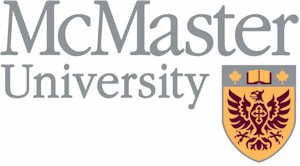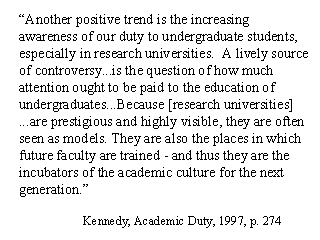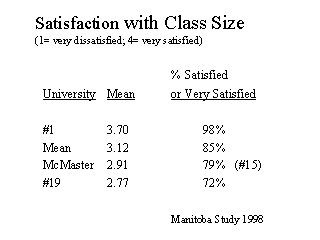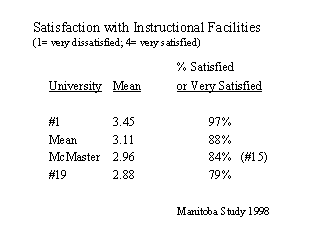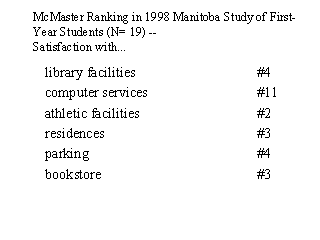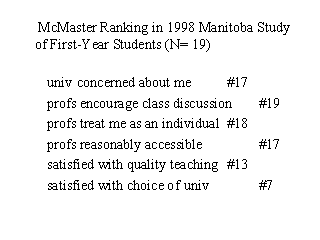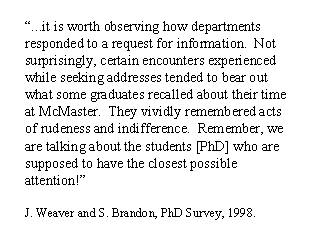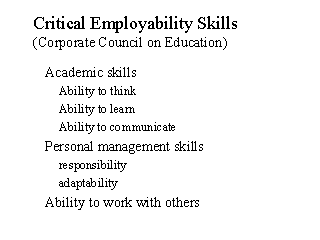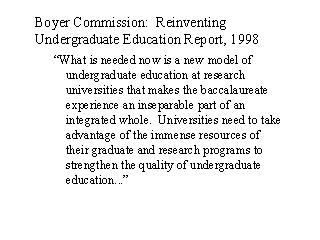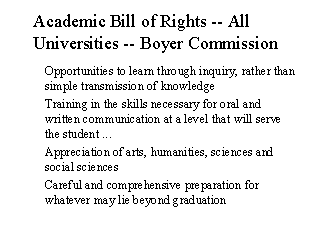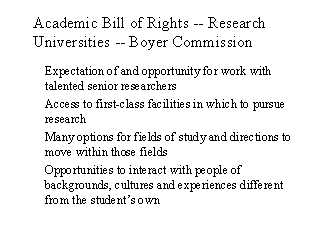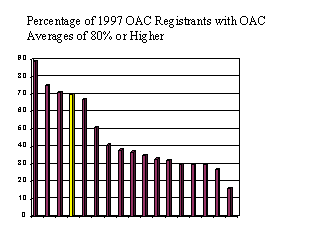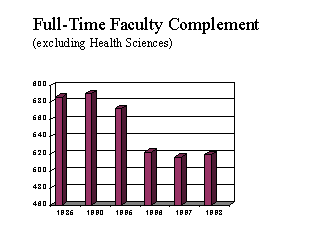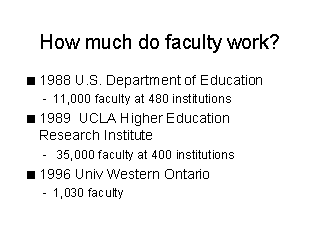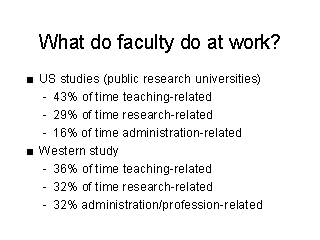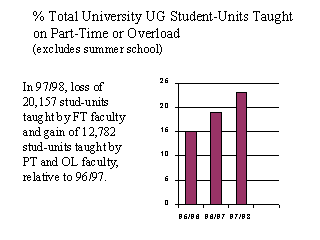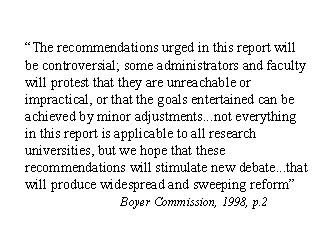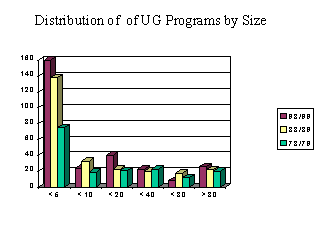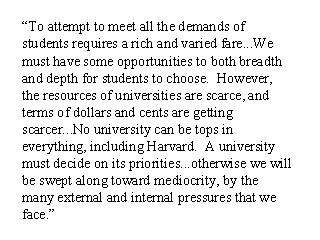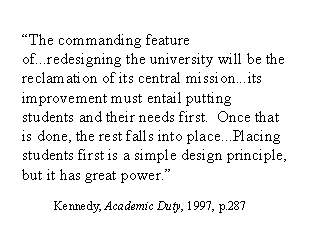|
WHAT IS ACADEMIC DUTY? PUTTING STUDENTS FIRST The concept of academic duty comes from the book titled Academic Duty, published in 1997 by Donald Kennedy, former president of Stanford University. Academic duty is presented as the necessary counterpoint to the concept of academic freedom. Academic duty refers to the responsibility and duty of the professoriate. Kennedy describes it this way:
There are many duties of the professoriate including their responsibility to society, their profession and students. The book, in fact, provides a riveting and scholarly discussion of the duties of the faculty to these various groups and in these various domains. I recommend it highly. But, in today’s talk, I want to concentrate specifically on our academic duties to students, to teaching. In any discussion of academic duty, this seems a natural place to start. Why? First, although I am not a big fan of dichotomizing the work of the professoriate into teaching and research, we must acknowledge that one of the primary roles of faculty is to teach, to profess. Second, of all of the activities of the professoriate, teaching, especially in research-intensive universities such as ours, is often seen or perceived to take a second place to higher-level activities such as research. It is worthwhile to examine the validity of this perception. Kennedy summarizes these issues well in his book: This address will focus on academic duty, with emphasis on our duty to students and teaching, primarily at the undergraduate level; all discussed, of course, in the McMaster context and perspective. With respect to our academic duty to undergraduate teaching, I will address essentially three questions:
DO WE KNOW WHAT STUDENTS WANT? If we want a first approximation of our academic duty, it seems reasonable to start by asking those individuals who seek university education, i.e. the students. There are many studies that have been done to assess why students attend university and their perceptions of their university experience. To be fair, some of these surveys are more rigorous than others; the methodology of some is limiting. That said, let’s examine some recent surveys that are particularly relevant to understanding what McMaster students look for in a university education and how they assess their McMaster experience. McMaster Image and Perception Study (1996): For this study, 600 individuals were surveyed about their perceptions of McMaster and its image. Relevant cohorts for this talk are 250 prospective students – those who applied to McMaster but had yet to attend – and 100 current students. Welcome to McMaster Survey (1998): Commissioned by the Enrolment Management Team, this survey of 1,760 first-year students (53% of the entering class) focused on recruitment issues but contains data on why students were interested in McMaster and why they picked McMaster over other schools to which they had applied. Survey of First-Year University Students ( 1998):This study by the Canadian Undergraduate Survey Consortium, called the "Manitoba Survey," compares the first-year experience of McMaster students to that of students in 18 other universities. This survey is particularly informative because of the comparisons it allows with other institutions. The first thing that comes through clearly and consistently is that the dominant motivation for attending university is the student’s desire to get a good job and to be prepared for the workplace.When asked for the reasons why they chose to attend a university, 84% of the Manitoba study participants said "to get a good job." This was the most frequent answer. Here at home, 81% of first-year students in the Welcome to McMaster Survey indicated that getting "a good job" was a very important reason in their decision to attend a university (Again, the most frequent answer). When asked why they chose to attend a particular university, the quality of the academic programs and the reputation of the university are the most frequently-cited reasons. To be fair, most students are generally satisfied with their university experience. In McMaster’s Image and Perception Study: * 20% of students indicated that McMaster exceeded their expectations, 71% indicated that McMaster met their expectations, and only 9% said that McMaster did not meet their expectations. * 73% of current students indicated that they would be very likely to recommend McMaster, 25% indicated that they would be somewhat likely and only 2% indicated that they would not be likely to recommend the university. * 82% of first-year students said that they are satisfied with the quality of teaching they have received. What these surveys tell us is that students attend university for career reasons. Within that, they look for academic programs that they believe will lead to the good jobs. Overall, while they are at university, they tend to be reasonably satisfied. But, there are data sets that might be more helpful, at least in terms of predicting how students ultimately rate their university education and how they perceive McMaster relative to other post-secondary institutions. The first is whether, after graduation, students remain satisfied with their university experience. There are very little data to make this assessment. What we need is a more detailed analysis of students after graduation, i.e., after they have had a chance to assess whether their university experience truly allowed them to achieve their goals and aspirations. One such study is being conducted by our School of Graduate Studies. The second issue is how McMaster compares with other institutions. Again, we have little data on this and the measurement issues are challenging. But, the Manitoba survey does allow us to assess at least the first-year experience. These data suggest that the first-year experience at McMaster may not fare so well.
These data are consistent with other indicators, such as the Maclean’s magazine rankings, and a 1995 analysis of students in first-year natural sciences. In general, we have biased a high proportion of our teaching resources to the third and fourth years. The question is whether we have allocated sufficient resources to Levels I and II. There is sentiment that we have not. The budget allocation to Year I inquiry courses, and efforts to reduce class sizes in years one and two, are some of the efforts to redress this imbalance. In general, then, our students are satisfied, although perhaps not as satisfied as students at other universities – there is more dissatisfaction about Year I and much of this relates to large classes and the impersonality of the experience. What we can do about this is to re-emphasize the Year I experience. The large classes create a general sense of the university as uncaring or, to use a term that was used in the natural sciences report, dehumanizing. This can also be seen in some of the other Manitoba rankings.
This sentiment is not restricted to first-year students as you will read in the following quotation, taken from the preliminary report of the McMaster PhD Graduate Survey. DO WE KNOW WHAT THE CORPORATE SECTOR WANTS? If a major motivation of students to attend university is to get a good job, one of our duties may be to have academic programs that prepare students for the workplace. I did not say that our sole duty sole was to give students the skills or credentials to get good, that is high-paying, jobs. Certainly there are other purposes to a university education, including issues such as personal growth, exploration and maturation, the cultivation of interests and intellectual pursuits beyond those that will be useful in one’s own workplace, etc. The student surveys acknowledge the students' interests in these as well. But, we would be naive if we did not admit that a motivation for some, perhaps many, to pursue university education, despite the cost, is the belief that it will lead to a better job, at higher wages, and a better quality of life. All of the economic analyses I know of reinforce this belief. What do corporations tell us are the employability skills that students must demonstrate to obtain those good jobs that they seek?
DO WE KNOW WHAT UNIVERSITY THINK TANKS WANT? I have already mentioned Kennedy’s book and his view, and that of others, that too little attention is paid at universities, particularly research-intensive ones, to teaching. The best analysis we have of the state of teaching at research-intensive universities, and how well we are fulfilling our duty at this level, comes from a 1998 report funded by the Carnegie Foundation for the Advancement of Teaching titled "Boyer Commission on Educating Undergraduates in the Research University: Reinventing Undergraduate Education." That report provides a harsh and stinging indictment of the quality of teaching at research-intensive universities. It stresses these universities because, although there are about 3,500 colleges and universities in the US, almost all of the professors come from programs in about 100 top research-based universities. What they suggest is that a new model of undergraduate education is needed.
It is instructive to note the concordance between the Boyer Commission's "Academic Bill of Rights" and the "Critical Employability Skills" identified by the Corporate Council on Education. The Commission’s recommendations are specific: * Research-based learning should be the standard. Learning to be based on discovery guided by mentoring, not the transmission of knowledge; students to be involved in research; student mentors; internships. * Establish first-year inquiry-based program. Central to the first-year experience, inquiry has two functions: it serves as a bridge between high school and the more independent, free-thinking world of the research university; it excites the student by the wealth, diversity, scale and scope of what lies ahead. *Build on the first-year experience in subsequent years. The first-year experience is consolidated by continuing it in later years through inquiry-based learning, writing, communication, etc. * Remove barriers to interdisciplinary education. As research is more interdisciplinary, teaching must follow. * Link communication skills and course work. Students must acquire strong communication skills, graduates who are proficient in both oral and written communication. * Use information technology creatively. Evaluate its efficacy! * Culminate with a capstone experience. The final semester should be an opportunity for a major project to utilize fully the research and communication skills that have been learned. * Educate graduate students as apprentice teachers. They are the next generation of faculty. Graduate education should prepare these putative faculty to teach undergraduates. * Change faculty reward systems. Research universities must commit themselves to the same standards in teaching as we expect in research and to create faculty reward systems that validate the commitment. Synergy of teaching and research. Evaluate teaching. * Cultivate a sense of community. Formally establish a community of learners – a sense of place, through the provision of space for students to meet and discuss; informal spaces for work. To be fair, McMaster is not doing all that badly relative to the report card of other institutions. We have: * a strong tradition of inquiry-based learning and one that we are promoting even further through initiatives such as the Centre for Leadership in Learning. * introduced first-year inquiry courses and have a commitment to do more although there is a general sense that the first-year experience needs attention. * been more conscientious and aggressive than other institutions in promoting interdisciplinary teaching models such as the Arts & Science Program, the Theme Schools and the Strategic Areas exercise. * independent study and a senior research thesis as a capstone experience in many departments, but the number of opportunities are dwindling. * a course to prepare our graduate students to become more effective teachers (offered by the Instructional Development Centre). But the demand exceeds our capacity. * promoted the bicameral role of faculty as both teachers and researchers; this is enshrined in career progress as defined in the criteria for tenure and promotion. We promote the importance of the synergy between teaching and research ( the concept of the scholar-teacher), but there are claims that we may not provide enough incentives. But, in truth, these data are anecdotal. We need to know where we stand. I will be asking Undergraduate Council to organize a report to determine how we fare relative to the Boyer Commission recommendations and, where deficient, to provide realistic goals, and to translate the Boyer recommendations into action plans for McMaster. WHAT PREVENTS US FROM FULFILLING OUR DUTY? There is little that has been identified as goals for undergraduate education that should give us pause. After all, we are all so invested in the research culture, who could object to the idea that we should share it with our students? Also, who could disagree that the promotion of thinking, inquiry and communication skills is part of what we should do at the undergraduate level? In fact, most faculty I know agree wholeheartedly that this is what we should be doing. Also, those who have taken the plunge into inquiry courses typically describe it as a very positive experience. What, then, are the constraints? One is that we may not have the students to teach this way. The Boyer recommendations would drive the institution to placing more responsibility for education in the hands of the students. We would be asking students to think more (rather than simply memorizing), research more, be more independent. These are not a bad set of expectations but some suggest that one needs a group of students with a certain level of intellectual substrate to pull this off. The data (that shows the percentage of the entering class who have OAC averages greater than 80% for 17 Ontario institutions) below suggests that we have such students. On this measure, we ranked fourth in Ontario in 1997. We have good students. We have reasonable standards. Those students who cannot make it drop out; others rise to the level of expectation.
WHAT ARE OTHER POSSIBLE CONSTRAINTS? One, of course, is that all of the recommendations being made – smaller classes, more inquiry – require more faculty. The loss of full-time faculty is the most tangible reflection of the decreased public support of universities and its most damaging consequence. In Ontario, we have lost approximately 1,000 full-time faculty; within this same period there has been an increase in university enrolment of more then 8,000 students. The faculty complement at McMaster is shown below. This is likely to be our steady state and it is only fundraising, endowed chairs and revenue generation that may allow us to rise significantly above the current level.
There are some who suggest that faculty should just put in longer hours or devote more of their time to teaching. The latter sentiment is often expressed about research universities because of the view that faculty in those institutions spend too little time on teaching and too much on research. What do we know about faculty workloads and time distributions?
Faculty who work the most hours per week tend to be those at research-intensive universities.A British university study suggests the more senior the faculty, the greater the number of hours worked. Those most burdened members of the professoriate may be female faculty. But, could faculty just devote more time to teaching? The data below suggest that faculty at research universities spend as much, if not more, time, on teaching as they do on their other duties. This suggests that it is unlikely that we can solve the problem by simply doing more. (But we can recruit more faculty into undergraduate programs and this is one of the effects of the proposed Bachelor of Health Sciences undergraduate program.)
How has McMaster managed to maintain its teaching duties in the face of the dramatic faculty departures? Part of the answer is an increased reliance on part-time and overload teaching. The next graph shows the percentage of our undergraduate teaching that is being done by other-than-full-time faculty on load – this includes sessional lecturers, full-time faculty teaching on an overload basis and part-timers.
We find ourselves, then, in a dilemma. To fulfill our academic duty, we are being told that we should spend more time cultivating the thinking and communication skills of students. We should be offering more research opportunities. But we are to do this during a time of scarce resources and, as an indication of this, when we are relying more and more on other-than-full-time faculty to carry the instructional load. WHAT STRATEGIES MAY ALLOW US TO FULFILL OUR DUTIES? I reject the solution of simply staying complacent. We need fundamental change. We will not get there by simply tinkering here and there. Let me provide what I think are a number of solutions that McMaster should entertain. I provide the suggestions in the following spirit:
1. A reaffirmation of a commitment to undergraduate education which must be: * more than rhetoric. We need to know where we stand. To this end, I am requesting Undergraduate Council to develop a report card for McMaster that measures our performance relative to the recommendations contained in the Boyer Report. * tied to resource allocation (includes budget and appointments). Hiring decisions must help us understand how the appointment intersects and assists teaching plans, a process that was inherent in the Strategic Areas exercise. In the hiring decision, we need to apply the same rigor to the evaluation of teaching as we do to research. * consistent with the promotion of the linkage between scholarship and teaching expected in a research-intensive university. This is where we need to worry about the balance and respective contributions of full-time versus part-time faculty. As a corollary of this, we should expect evaluation of things we do. In sum, all that is being asked for is a transfer of the research culture – which we all hold so dear and near – to the teaching enterprise. 2. Simplification of our undergraduate programs. The graph below shows the proliferation of undergraduate programs. In 1978-79, we had 173 programs (8,846 students). In 1988-89, we had 251 programs (10,584 students). And in 1998-99, we had 301 programs (12,229 students).
The growth in programs has been almost exclusively one in which the cumulative enrolment in Levels II-IV is less than five. If we set a five-person threshold on enrolment, we would eliminate over 50% of our programs. If we set a 10-person threshold, we would eliminate over 60% of our programs. I am asking Undergraduate Council to consider these recommendations, or others that would simplify undergraduate programs and ease the administrative and counseling burden. Part of this task may include creating guidelines for the development of generic program requirements and the harmonization of these regulations across the Faculties. 3. Lighten the administrative load of faculty. I make this recommendation every year and it never goes anywhere, but at least I am consistent and persistent. Faculty members have three roles in the academy: teaching, research and administration. Of these, the least important is the administrative role; everyone complains about it but no one is willing to do anything about it. It is time to: * assume that support staff can do their jobs; * let your duly-appointed academic administrators carry the administrative work. I am a great fan of accountability. If we do a bad job, get rid of us. But faculty in the trenches should remove themselves as much as possible from administration. This does not mean everything. The collegial administrative mode requires the ongoing participation of faculty in university governance. But, we should always ask if a particular administrative task for a faculty member is necessary and, for those that are not essential or too deflecting from teaching and research, consider lessening the faculty involvement. 4. Rethink the way teaching is assigned. Currently, all teaching done by faculty is controlled by the chair. If a faculty member wants to teach outside his/her department, his/her services must be bought through the transfer of money to the department to liberate the faculty member’s time. This is perhaps the last remnant of slavery in North America and it is particularly ironic that it exists in an environment that claims academic freedom as one of its central tenets. This process is also inconsistent with the teaching inclinations of many faculty. It is time to develop a pool of teaching resources, that lie beyond the departments, to allow us to pursue educational initiatives that cross department boundaries such as Theme Schools, or that serve more general institutional objectives, e.g., inquiry-based programs. Suggestions here are perilous because they appear to attack the fundamental administrative structure of universities. Even members of the Boyer Commission were cautious about this. What can we do? * We can consider the model currently used by the Faculty of Humanities which stipulates a three-unit contribution to a Faculty teaching pool for each new appointment. Or, * We can institute a tax on teaching that would generate a University pool. This has added advantage, perhaps, of moving to equalize the contribution of various units to undergraduate education and for allowing units with lower undergraduate teaching loads to assist those with higher loads. Whatever we do, we must do across the institution. We talk a great deal about collegiality. It is time to reaffirm some collegiality in the application and allocation of teaching resources. You can expect a specific proposal to be brought forward to the university for discussion. I would like to end with the following quotation:
These remarks come from a 1970 talk given by University President Harry Thode to the Senate Committee on Academic Policy. It is instructive that this focussed on graduate programs. This was appropriate given the incredible expansion of graduate programs at the time. I have not discussed graduate programs in this talk but this should not be taken as a sign of lessened interest or concern about graduate studies. In fact, the thrust of the Boyer Report is the suggestion to extend the typical way we educate graduate students to the undergraduate population. Academic planning about graduate studies deserves attention but would have to be the topic of another talk. We do need to make tough decisions. Our infrastructure is light and it shows. Our support staff and faculty are taxed. We are so busy worrying about operational items – simply keeping the place going – that we do not have enough time for reflection and innovation. Our buildings are failing, our facilities need upgrading, and we need to paint the hallways. My central point here is that as we move forward, and we will, our duty to undergraduates needs to occupy a central place in our thinking and planning. The views of students, corporate leaders and think tanks within universities provide us with a consistent and coherent framework in which to plan. It is a framework that is particularly well-suited and attractive to a University, like ours, that defines itself as committed to research, evaluation and excellence.
|
